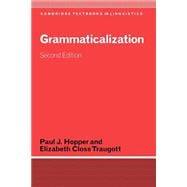
Note: Supplemental materials are not guaranteed with Rental or Used book purchases.
Purchase Benefits
What is included with this book?
| List of figures | xiii | ||||
| List of tables | xiv | ||||
| Preface and acknowledgments | xv | ||||
| List of abbreviations | xviii | ||||
| 1 Some preliminaries | 1 | (18) | |||
|
1 | (3) | |||
|
4 | (5) | |||
|
4 | (2) | |||
|
6 | (1) | |||
|
7 | (2) | |||
|
9 | (7) | |||
|
10 | (3) | |||
|
13 | (2) | |||
|
15 | (1) | |||
|
16 | (1) | |||
|
16 | (1) | |||
|
17 | (2) | |||
| 2 The history of grammaticalization | 19 | (20) | |||
|
19 | (1) | |||
|
19 | (6) | |||
|
25 | (5) | |||
|
30 | (9) | |||
| 3 Mechanisms: reanalysis and analogy | 39 | (32) | |||
|
39 | (1) | |||
|
40 | (10) | |||
|
41 | (2) | |||
|
43 | (2) | |||
|
45 | (1) | |||
|
46 | (4) | |||
|
50 | (8) | |||
|
52 | (3) | |||
|
55 | (3) | |||
|
58 | (5) | |||
|
59 | (4) | |||
|
63 | (5) | |||
|
68 | (1) | |||
|
69 | (2) | |||
| 4 Pragmatic factors | 71 | (28) | |||
|
71 | (3) | |||
|
74 | (7) | |||
|
76 | (1) | |||
|
77 | (1) | |||
|
78 | (3) | |||
|
81 | (11) | |||
|
84 | (3) | |||
|
87 | (5) | |||
|
92 | (2) | |||
|
94 | (4) | |||
|
98 | (1) | |||
| 5 The hypothesis of unidirectionality | 99 | (41) | |||
|
99 | (1) | |||
|
100 | (6) | |||
|
101 | (3) | |||
|
104 | (2) | |||
|
106 | (9) | |||
|
110 | (1) | |||
|
111 | (3) | |||
|
114 | (1) | |||
|
115 | (9) | |||
|
116 | (2) | |||
|
118 | (4) | |||
|
122 | (2) | |||
|
124 | (2) | |||
|
126 | (4) | |||
|
127 | (1) | |||
|
128 | (1) | |||
|
129 | (1) | |||
|
130 | (8) | |||
|
138 | (1) | |||
|
139 | (1) | |||
| 6 Clause-internal morphological changes | 140 | (35) | |||
|
140 | (1) | |||
|
140 | (19) | |||
|
142 | (1) | |||
|
143 | (8) | |||
|
151 | (3) | |||
|
154 | (5) | |||
|
159 | (6) | |||
|
165 | (7) | |||
|
165 | (3) | |||
|
168 | (4) | |||
|
172 | (2) | |||
|
174 | (1) | |||
| 7 Grammaticalization across clauses | 175 | (37) | |||
|
175 | (1) | |||
|
176 | (8) | |||
|
179 | (2) | |||
|
181 | (2) | |||
|
183 | (1) | |||
|
184 | (6) | |||
|
190 | (14) | |||
|
190 | (4) | |||
|
194 | (2) | |||
|
196 | (8) | |||
|
204 | (5) | |||
|
204 | (2) | |||
|
206 | (1) | |||
|
207 | (2) | |||
|
209 | (2) | |||
|
211 | (1) | |||
| 8 Grammaticalization in situations of extreme language contact | 212 | (19) | |||
|
212 | (1) | |||
|
213 | (6) | |||
|
214 | (2) | |||
|
216 | (3) | |||
|
219 | (5) | |||
|
219 | (3) | |||
|
222 | (2) | |||
|
224 | (7) | |||
| 9 Summary and suggestions for further work | 231 | (3) | |||
| Notes | 234 | (3) | |||
| References | 237 | (28) | |||
| Index of names | 265 | (5) | |||
| Index of languages | 270 | (2) | |||
| General index | 272 |
The New copy of this book will include any supplemental materials advertised. Please check the title of the book to determine if it should include any access cards, study guides, lab manuals, CDs, etc.
The Used, Rental and eBook copies of this book are not guaranteed to include any supplemental materials. Typically, only the book itself is included. This is true even if the title states it includes any access cards, study guides, lab manuals, CDs, etc.